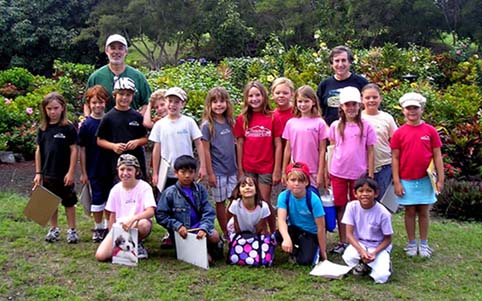Schools at the Galaxy Garden
Galaxy Program at Science Camp
Sierra-Marie Gerfao contacted me in June about a project she was planning for a kids science camp she was managing. The happy result can be found below. it opens a whole new dimension of possibilities for balloon galaxy models. She writes:
"I have made a blog post about our Galaxy program here:
http://lifespanfaithdevelopment.blogspot.com/2009/08/uu-galaxy-report-back-to-mission.html"
West Hawaii Explorations Academy
Galaxy Garden Reflection by Ben Perreira
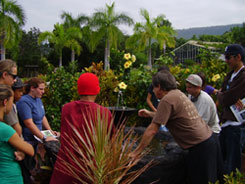
On February 25, 2009, a group of my classmates and I went to the Galaxy Garden at the Paleaku Peace Gardens Sanctuary. The experience was quite interesting, it gave a different feel on the galaxy. My knowledge of the galaxy before this trip was very basic, and I believed that we were in the middle of the galaxy. During a camping trip, a classmate pointed out the Milky Way in the night sky, which was very confusing for me because I thought that if we were in the Milky Way, how would we be able to see it.
This trip gave me a totally different idea of the galaxy, and now I understand it much better. By actually going to the Garden, and being able to see Earth's place in the galaxy, to scale, was eye opening. From this experience I learned and got a better understanding on how small we actually our, and the size of our galaxy.
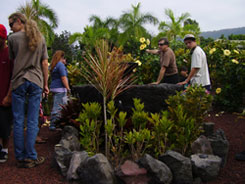
The Galaxy Garden provided a visual and physical feel of the galaxy. I believe that going to the Galaxy Garden is eye opening, and will allow anybody to understand the galaxy better. The Galaxy Garden represented each astronomical objects with either a plant or another object. I thought that the crushing cinder to represent the static was brilliant, along with the 'unknown' objects scattered around the garden. I personally feel that the Galaxy Garden is a great representation of the galaxy and that it can educate anyone.
Galaxy Garden by Philip Mothes

On Wednesday February the 25, the galaxy garden project at WHEA, had a fieldtrip to the Galaxy Garden in the Paleaku Peace Gardens Sanctuary located in Kona, Hawaii. Upon arrival, Jon Lomberg met us at the entrance and guided us inside the premises. Once inside, he explained what the galaxy is and how small we are compared to it. After he showed us pictures and gave us a poster, he guided us outside to the Galaxy Garden.
This garden is designed to represent our galaxy. The garden is 100 feet in diameter. All spiral arms are represented by plant beds, and all plants in theses beds represent solar systems or nebulas. The ground is made out of red and black rocks that crunch when walked upon. This is used to demonstrate the radiation that was left over from the Big Bang which can be heard in between station of a radio. The red rocks represent stars that are alive, whereas the black ones means that they are burned out.
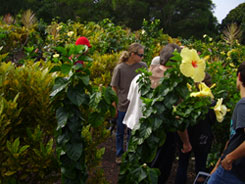
The most interesting thing was that entire solar systems are represented by tiny dots on the plant leafs. Our solar system was just represented by a tiny needle on a plant leaf. In the middle of the garden there was a water fountain inside a bar shaped cement block, this cement block represents the galactic bar, and the water fountain the black hole inside of the galaxies center. This was an awesome experience, and I am thinking of going there again. The garden was able to make me understand a little bit better where in the galaxy we live, and the phenomenal distance that makes up our galaxy.
Student Visitors
These thank you notes from Mr. Sabo's 3rd grade class are delightful. I especially like the boy standing in the garden saying "Its amaze" and the nice line drawing of the fountain/galactic center and jets. Kids grasp the idea of the galaxy very well, maybe because they have fewer preconceptions about the place of our planet in the larger scheme of things.


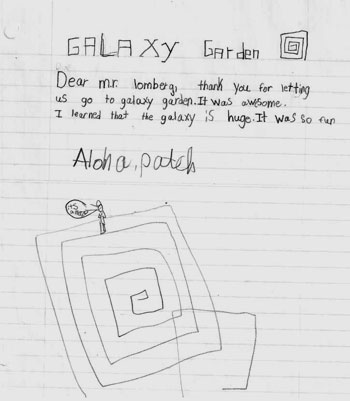
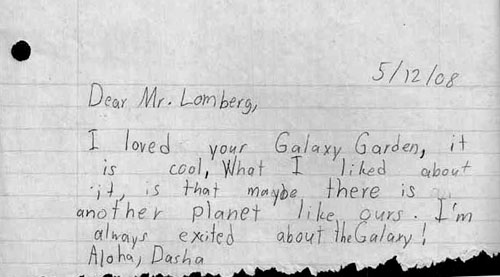
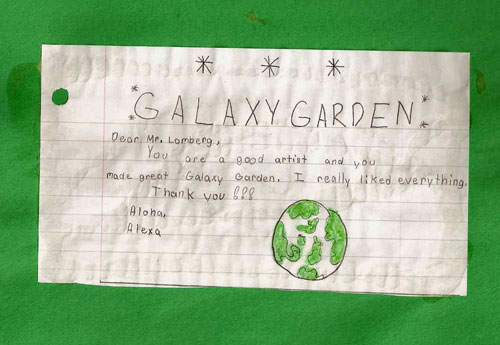
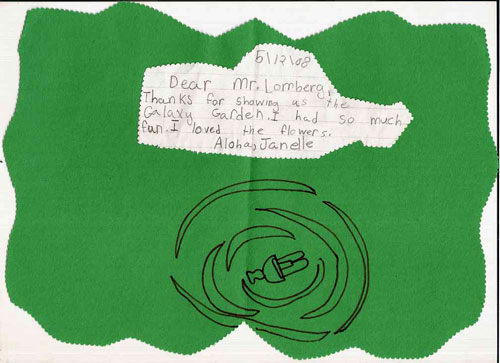
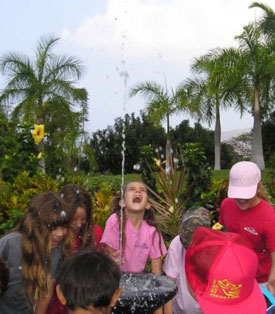
Student News Story
Below is an editted version of the story written for the Wildcat Newspaper of Konawaena High School in Kona, Hawaii, during construction of the Galaxy Garden last school year. The author is student Ashley Raleigh.
Planet Plant-It
"This is the first of its kind." Have you ever thought it possible to be able to take a short walk through our entire galaxy? Passing by the solar system and getting close enough to a black hole to touch it, but still not get sucked in and morphed into a Stretch Armstrong? The time has come, for us to get to know our surroundings from a different point of view- a view in space. A view from the top!
The Galaxy Gardens were once a mere pipe dream of astronomer and head designer Jon Lomberg. After 5 or 6 years of perfecting the details and working to make the idea into a reality, Jon got a little help ... from Paleaku Gardens.
"They were so helpful... They're a non-profit organization, so it was from the heart. The most difficult part of this process was finding a flat peice of land here that was the right size." Mr. Lomberg also wanted to thank the Change Happens Foundation, and the New Moon Foundation for their generous donations. Now, all that is needed is the volunteered time of good people to make sure the gardens are completed. Jon predicts it should be by summertime. Miss Stavrovsky's Earth Science students and members of the Astronomy Club have offered up their time every Wednesday, and have recently begun cleaning up the areas surrounding the garden. By transporting and watering the plants, digging trenches, getting dirt under their fingernails, and snapping photos along the way, they are living history right now. Anyone who is interested in helping can ask Miss Stavrovsky for details.
The gardens themselves have been planned out so precisely that the distance between each flower and plant has been calculated to be an exact scale model of the distances between planets and stars. The colors of each flower petal and every spot on each leaf represent a color or presence of every planet, star or any other type of matter in the atmosphere. The plants have been set up in a swirling circular pattern on the land, as to show that our galaxy is in a constant spiraling motion. Earth, for now, is represented by an orange cone, but it will soon be replaced by a fitting type of plant. Jon has decided it would be best to start out with Earth in the order of planets, so one would be able to compare the rest of the galaxy accordingly. The black hole of our galaxy has temporarily been represented by a large piece of lava rock. "Its black, and has holes", Jon explained with a chuckle. Future plans for making it more realistic include a fountain to show the X-rays emitted by a black hole, and a mirror underneath to project the three-dimensional look.
Never before has a scale model been built of our galaxy like this one. Jon states he believes this is because there is not yet enough known about our galaxy, so we settle for our well-known solar system instead. Working together with astronomers and scientists, and doing research of his own, Jon has been able to gain enough knowledge to lead the pack and build this model with expert precision and detail. Much is expected from this journey and the outcome will be a momentous occasion in history. A website for this project is in the making so millions more will be able to access information about the gardens, view photos of volunteers working on the land, and contact those involved. Happy planting!
- Ashley Raleigh / Wildcat Newspaper of Konawaena High School
Student Participants
Students from Konawaena High School supplied much of the volunteer labor. They dug out rocks, hauled dirt and spread cinder, and put many of the plants into the ground. During each session we would talk about the garden they were helping to build. The comments below show how much they gained from the experience:
"I didn't realize how small Earth is compared to the galaxy..."
- Brian
"Wow, that Earth is small. I thought it would be bigger."
- Ramon
"That's a big a garden, Miss..."
- Colt
"After working for the galaxy gardens, I started thinking that there HAS to be other life in the galaxy because of all the other stars out there. I mean, there's only one planet we know of that has life, but there are billions of other stars out there... there has to be other life out there. How can there not be life out there with all those other stars?"
- Colt
"But aren't there other colors of stars in the galaxy besides yellow? Where are the red and blue and orange stars?"
- Frank
"Miss, that was a lot of hard work doing that garden! I was sweating! But I had a lot of fun! When are we going again?"
- Aisha
"I liked how this garden helped me to understand our constellations better. I never knew why the Milky Way looked different throughout the year, now I understand why. I feel like it is hard for me to explain it in words, but in my head I feel like I understand it. I can picture us on the Earth looking towards the center of the galaxy in the summer and in the winter I picture us looking away from the center of the Milky Way. I hope that makes sense! This garden might have raised more questions than answered some... maybe that is good! I like thinking about these kinds of things."
- Caylee
"This is a really cool project. I hope we get to work on it more. I love to learn this way. We should create a website so people can learn about this..."
- Katie
"I didn't know there was a black hole at the center of the Milky Way. I didn't even realize that the Milky Way was our own galaxy. I thought it was just a candy bar and a cloud of stars in our sky. This garden helped me to understand our position in the galaxy, I think that was the point of the garden. I always thought the Earth was in the center of the galaxy, but we are actually farther out than that. I really liked getting out of school to work on the garden too. Sometimes you can learn by doing and building something like the galaxy garden instead of sitting and listening to teachers. It is really pretty in the garden too. I think once it grows it will look really nice. I'm glad I was able to work on it."
- Alvin
"It was cool."
- Kekoa (A man of many words :) )
"So, Miss, if I took one step in the garden, it is 1000 light years? Whoa, that's cool! We should invent a machine that can travel like that."
- Michael
"I had a lot of fun working at the garden. I can't believe how big the Milky Way is compared to the Sun and the Earth! Working for the gardens made me think about how much time it took for the universe to be created. We learned it took 15 billion years, but is that true? This garden made me think of whoever came up with this galaxy and universe was a pretty neat person, or thing, or whatever..."
- Kamal
"What did I learn at the galaxy gardens? What DIDN'T I learn is more like it! I was surprised to learn that what we see in the sky at night is only in a small part of the galaxy surrounding the solar system. I thought that scientists knew so much about all the stars and galaxies around the solar system and sun, but I found out working for the garden that there is a lot we don't know. I started thinking about where other galaxies would be compared to our Milky Way... how far away would they be? How far away would the closest galaxy be? How far away would the farthest galaxy be? Are there more people out there? Where are they? What are they? Are there really that many stars? Is there stuff out there we can't see? Can you hear sound in space? When it was quiet in the garden it made me think a lot about sound... Like supernovas... when they blow up, can you hear them?"
- Courtney
